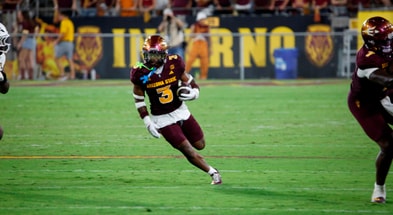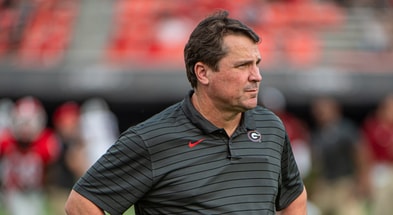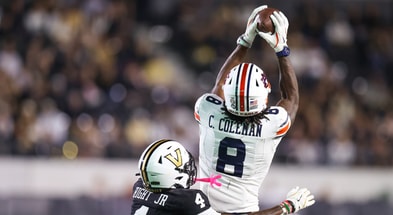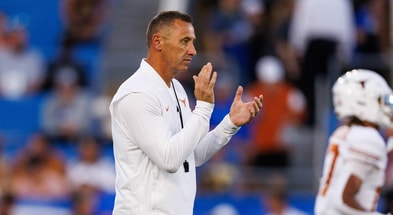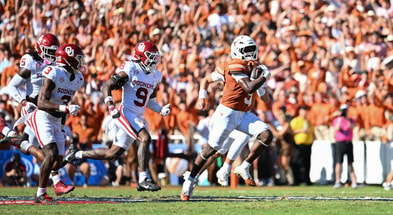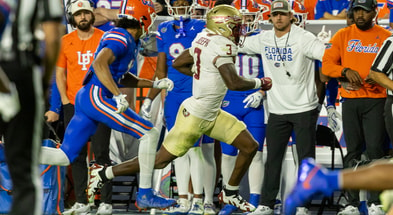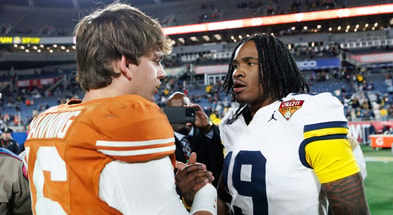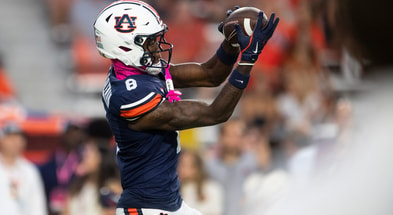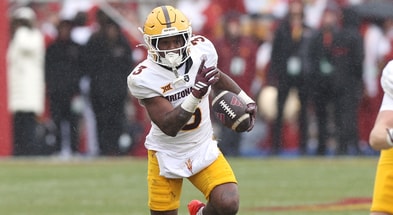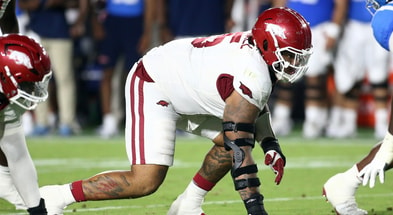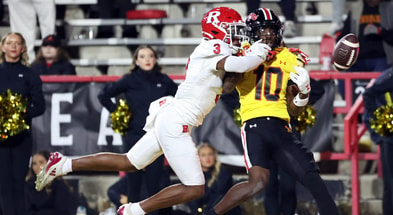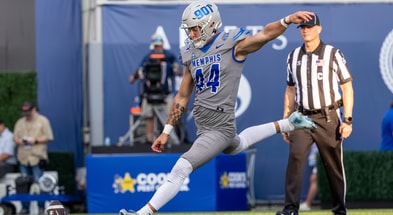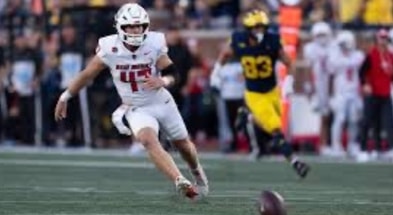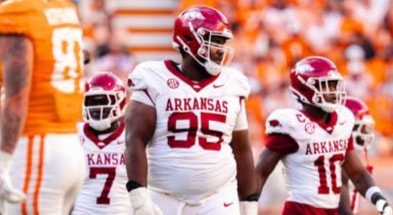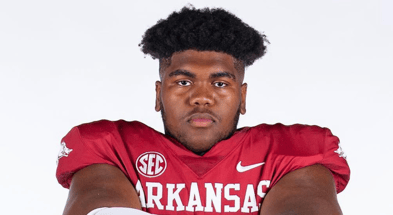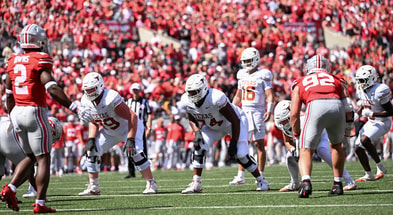Film Room: Is Texas' defensive front affecting opposing offenses? Barryn Sorrell says yes
So far this season, the Texas defense has logged 7.0 sacks through four games. Those numbers might seem meager for a team that’s tied for first in scoring defense as 7.0 is good for No. 66 in the country (the Miami Hurricanes lead with 16.0). But though the room hasn’t produced a significant number of sacks, the defensive line has made a considerable impact on all four Longhorn wins.
[Join Inside Texas TODAY and get the BEST Texas Longhorns scoop!]
That includes when opponents are passing.
“I would say very good, just because looking at the film and seeing the way we’re affecting the quarterback, no quarterback is able to sit back there on third down,” Texas EDGE Barryn Sorrell said Monday about the Texas pass rush. “That’s really our job. Sometimes we’re able to capitalize on the sacks, and sometimes we’re not but we’re affecting the quarterback. In that case, we’re doing very good.”
Texas is better in earning tackles for loss with 27.0 on the season, good for No. 27 nationally and behind No. 1 Duke’s astounding 46.0 TFL.
There are a number of factors that explain why Texas’ sack totals are low at the current juncture. Colorado State, a passing offense of the Air Raid variety, didn’t want to subject its offensive line to having to block the Longhorn defensive line for an extended amount of time. Plus, once the game was out of hand, the Rams ran the ball to get back on the bus and save themselves for rivalry games and conference play.
Michigan’s passing acumen was almost non-existent with Davis Warren under center, and the Wolverines operate a run-first and run-second offense anyway. Similar applied to UTSA and ULM. Those are factors that make racking up sacks tough, but Sorrell isn’t worried so long as his side of the ball makes life difficult for opposing offenses and their signal-callers.
“At the end of the day, our job is to affect the quarterback,” Sorrell said. “You can’t control how long he’s going to hold the ball. You can’t control how the offensive line is going to protect.”
In addition, against those same teams and their rushing attacks, the Longhorns held firm and even drove the opponents back.
“On the run defense, I feel like it speaks for itself,” Sorrell said. “We feel like we’ve been doing our best. Obviously, the best is yet to come as we continue to progress throughout these weeks but I feel like we’ve been doing a very good job up to this point.”
Who else but Sorrell himself is the best illustration of the idea that the Texas defense is playing an all-around game and still impacting opponents on passing downs?
During the third quarter of the Longhorns’ 51-3 win over ULM, Sorrell individually affected all three plays to force a three-and-out and invite the Warhawk punt team onto the field. None of the plays were sacks, but Sorrell’s own play was emblematic of how the Longhorn defensive front has stifled opponents this season despite not racking up significant counting stat numbers in a certain area.
Play 1: 1st and 10 ULM from the -25
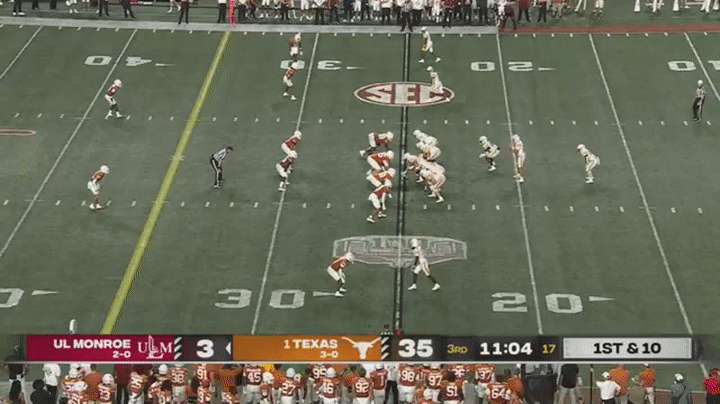
Sorrell, playing the Jack position in Texas’ 2-4-5 defense, gets double-teamed but manages to fight through it and get his hands on the ball carrier. Sorrell is credited for an assisted tackle along with Jermayne Lole. It’s an effort that keeps the play from bouncing outside and it’s a disruption that earns a spot in the stat sheet for Sorrell.
Top 10
- 1New
Kewan Lacy
Rebels RB decides on future
- 2Hot
Nebraska QB dominoes
Huskers line up multiple visits
- 3
Kenny Minchey
Flips transfer commitment
- 4Trending
Portal Predictions
Predicting transfer commitments
- 5
Bryce Underwood
Decides on Michigan future
Get the Daily On3 Newsletter in your inbox every morning
By clicking "Subscribe to Newsletter", I agree to On3's Privacy Notice, Terms, and use of my personal information described therein.
Play 2: 2nd and 8 ULM from the -27
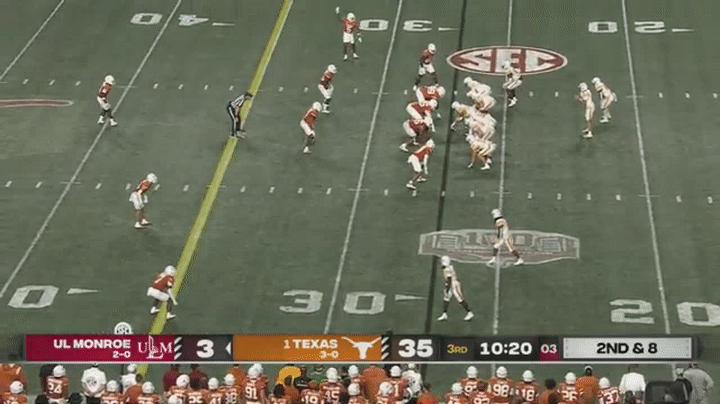
This is actually an interesting play from the Warhawks but Sorrell’s athleticism and execution that appears a touch off keeps it in the backfield.
Typically on the classic zone read, the offensive line leaves a defender unblocked and runs a zone play inside. The quarterback reads the unblocked defender. If the defender stays home in order to play the QB run outside, then the back is supposed to take the handoff and head up the middle. If the defender crashes to try to stop the RB, then the QB pulls the football and runs around outside.
This play seems to be some sort of attempt to mess with those rules. The RB takes a step toward the quarterback to fake a zone read and hopefully draw Sorrell in. Then, the back bounces outside as a counter to something regularly put on film. ULM hadn’t utilized General Booty as a rusher all that much ahead of this game with just nine rushes for 24 yards and only one attempt in the previous game. They weren’t about to do it in this game with Sun Belt play still ahead of them, but they wanted to mess with the Longhorn defense’s assignments.
Sorrell doesn’t bite on a play designed to be a pitch from the start. His athleticism helps him to track the ball-carrier down and once the cavalry arrives it goes down as a three-yard loss.
Play 3: 3rd and 11 ULM from the -24
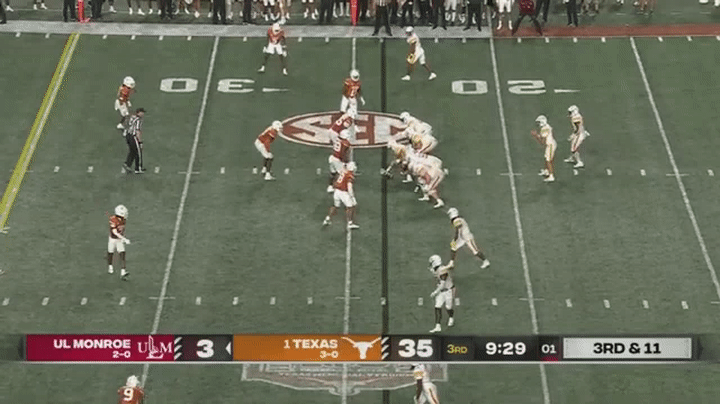
Here’s an example of the pass rush affecting the play without recording a sack, but instead netting a PBU. Sorrell, playing defensive tackle in the Longhorns’ dime package, recognizes he probably isn’t going to get to Booty while he’s taking a quick three-step drop. He keeps his eyes on the quarterback and tries to put his hand in the passing window and does so successfully.
Booty catches the batted pass, though he probably should have swatted it down. The Longhorn defense arrives to record a big loss after affecting Booty’s throw.
[Subscribe to the Inside Texas YouTube channel and help get us to 10,000 subs!]
Sorrell essentially forced a three-and-out almost by himself and showed how Texas has made life tough on opposing rush and pass offenses even though there might be limited counting stats for things like sacks. Texas is affecting the quarterback, and Sorrell is leading the charge.
